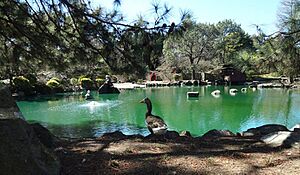Auburn Botanic Gardens facts for kids
Quick facts for kids Auburn Botanic Gardens |
|
|---|---|

The park's main lake from the entrance
|
|
| Type | Botanical, fauna, forest, wildlife park, nature reserve |
| Location | Auburn, New South Wales, Australia |
| Area | 13.1 hectares (32 acres) |
| Owned by | Cumberland Council |
| Visitors | 200,000 to 250,000 |
| Status | Open all year |
| Website | Official website: http://www.auburn.nsw.gov.au/Explore/AuburnBotanicGardens/Pages/AuburnBotanicGardens.aspx |
The Auburn Botanic Gardens is a fantastic botanical garden located in Auburn, a suburb of Sydney, New South Wales, Australia. It first opened in 1977 and covers about 9.7 hectares (24 acres).
This beautiful garden features two lakes, a lovely waterfall, and several bridges. The Duck River also flows through the garden, adding to its natural charm. The Cumberland Council takes care of the gardens. They are open every day, but there's a small fee to enter on weekends. One of the most popular spots is the Japanese gardens, which even attracts visitors from other countries!
Thousands of people visit the Auburn Botanic Gardens each year. Many come from outside Australia to enjoy the amazing plants and animals found here. The land was shaped to create different areas and even small "climates" within the garden. Three special areas are designed to show off Australia's natural beauty: the woodlands theatre, the native garden with a billabong, and the Australian rainforest. The gardens were officially opened by Sir Roden Cutler, the New South Wales governor, on September 11, 1977.
Contents
History of the Gardens
Before the gardens were built, this area was used to dig up clay for making tiles in the early 1900s. Later, it became a landfill site for waste. Over time, these soils were dug out to create the hills and lakes you see in the gardens today.
The gardens were designed by Eric Black. He was the chief engineer for the Auburn Municipal Council from 1949 to 1979. Community groups have also helped by adding a bonsai garden and an aviary. The native fauna reserve, which was planned with help from Taronga Zoo, was added later by the council's parks department.
The idea for the gardens came from a plan in the 1940s and 1950s. This plan set aside the land along the Duck River for fun and recreation. For many years, the council used to dump rubbish and sewage along the riverbanks and in the old clay pits. In 1968, Eric Black suggested creating a mix of sports fields and beautiful gardens along the Duck River. He imagined gardens with styles from different countries. While not all his ideas came true, parts of his vision, like the Japanese gardens and lake, the formal gardens, and the Australian habitats, were built.
Building work on the Botanic Gardens started in 1969. This included digging out the Japanese Gardens Lake. In 1973, hundreds of trees were planted in areas like the Avenue of Remembrance and the Woodland. The gardens also received funding from the Australian government in 1974 and 1975–76 to help with their development.
Nature in the Gardens
Plants and Trees
The plants and trees in the gardens have grown a lot since they opened. Some older trees and plants have even needed to be replanted. The New South Wales National Parks and Wildlife has recognized the gardens as an important place. They help protect certain environments and plant species. These include the Cooks River clay plain scrub forest, Acacia pubescens (also known as downy wattle), and Wahlenbergia multicaulis (Tadgell's bluebell).
Other interesting plants in the garden include pine trees, cherry blossoms, and azaleas in the Japanese Garden. You can find Frangipani, Lavender, and Sage in the Scented Garden. The Rose Gardens are full of different types of roses, like floribunda, grandiflora, petunias, and David Austin Roses. The woodland area has a thick canopy of leaves, creating a damp floor. This woodland is a small part of the original Cumberland Plain Woodland. It looks like an open forest with shrubs underneath the trees.
Animals in the Gardens
The Fauna Reserve opened in 1994. Here, you can see native Australian animals like wallabies, kangaroos, emus, rufous bettongs, and the common wombat. This reserve is designed so visitors can walk through and see these animals in a natural setting.
The aviary was officially opened on December 5, 1988. It is home to many Australian and Asian bird species. Migrating birds also often visit the Botanic Gardens. Outside the fauna reserve, you might spot animals like peacocks, swans, and other native birds wandering freely around the garden.
What to See and Do
- Japanese garden and Japanese rock garden
- Fauna reserve (where you can see native animals)
- Rose garden
- Scented garden (full of fragrant plants)
- Australian native and rainforest gardens
Gallery
-
An ornamental cherry blossom tree
-
Blossoming cherry blossom trees in the Japanese Garden
-
A goose on the lake
See also
 In Spanish: Jardín botánico de Auburn para niños
In Spanish: Jardín botánico de Auburn para niños

















